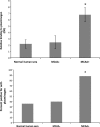Libby amphibole-induced mesothelial cell autoantibodies bind to surface plasminogen and alter collagen matrix remodeling
- PMID: 27519611
- PMCID: PMC4985547
- DOI: 10.14814/phy2.12881
Libby amphibole-induced mesothelial cell autoantibodies bind to surface plasminogen and alter collagen matrix remodeling
Abstract
Lamellar pleural thickening (LPT) is a fibrotic disease induced by exposure to Libby amphibole (LA) asbestos that causes widespread scarring around the lung, resulting in deterioration of pulmonary function. Investigating the effects of autoantibodies to mesothelial cells (MCAA) present in the study populations has been a major part of the effort to understand the mechanism of pathogenesis. It has been shown in vitro that human mesothelial cells (Met5a) exposed to MCAA increase collagen deposition into the extracellular matrix (ECM). In this study, we sought to further elucidate how MCAA drive increased collagen deposition by identifying the protein targets bound by MCAA on the cellular surface using biotinylation to label and isolate surface proteins. Isolated surface protein fractions were identified as containing MCAA targets using ELISA The fractions that demonstrated binding by MCAA were then analyzed by tandem mass spectrometry (MS/MS) and MASCOT analysis. The most promising result from the MASCOT analysis, plasminogen (PLG), was tested for MCAA binding using purified human PLG in an ELISA We report that serum containing MCAA bound at an optical density (OD) 3 times greater than that of controls, and LA-exposed subjects had a high frequency of positive tests for anti-PLG autoantibodies. This work implicates the involvement of the plasminogen/plasmin system in the mechanism of excess collagen deposition in Met5a cells exposed to MCAA Elucidating this mechanism could contribute to the understanding of LPT.
Keywords: Asbestos; Libby amphibole; autoimmunity; collagen; plasminogen; pleural fibrosis; proteomics.
© 2016 The Authors. Physiological Reports published by Wiley Periodicals, Inc. on behalf of the American Physiological Society and The Physiological Society.
Figures






Similar articles
-
Libby amphibole-induced mesothelial cell autoantibodies promote collagen deposition in mice.Am J Physiol Lung Cell Mol Physiol. 2016 Jun 1;310(11):L1071-7. doi: 10.1152/ajplung.00462.2015. Epub 2016 Apr 22. Am J Physiol Lung Cell Mol Physiol. 2016. PMID: 27106292 Free PMC article.
-
Mesothelial cell autoantibodies upregulate transcription factors associated with fibrosis.Inhal Toxicol. 2017 Jan;29(1):10-17. doi: 10.1080/08958378.2016.1271841. Inhal Toxicol. 2017. PMID: 28183202 Free PMC article.
-
Mesothelial cell and anti-nuclear autoantibodies associated with pleural abnormalities in an asbestos exposed population of Libby MT.Toxicol Lett. 2012 Jan 25;208(2):168-73. doi: 10.1016/j.toxlet.2011.10.024. Epub 2011 Nov 7. Toxicol Lett. 2012. PMID: 22085844 Free PMC article.
-
Amphibole asbestos in tree bark--a review of findings for this inhalational exposure source in Libby, Montana.J Occup Environ Hyg. 2012;9(6):387-97. doi: 10.1080/15459624.2012.682217. J Occup Environ Hyg. 2012. PMID: 22577793 Review.
-
A review of scientific literature examining the mining history, geology, mineralogy, and amphibole asbestos health effects of the Rainy Creek igneous complex, Libby, Montana, USA.Inhal Toxicol. 2006 Nov;18(12):949-62. doi: 10.1080/08958370600834982. Inhal Toxicol. 2006. PMID: 16920668 Review.
Cited by
-
Amphibole asbestos as an environmental trigger for systemic autoimmune diseases.Autoimmun Rev. 2024 Jul-Aug;23(7-8):103603. doi: 10.1016/j.autrev.2024.103603. Epub 2024 Aug 20. Autoimmun Rev. 2024. PMID: 39154740 Free PMC article. Review.
-
Autoimmune markers for progression of Libby amphibole lamellar pleural thickening.Inhal Toxicol. 2019 Sep-Oct;31(11-12):409-419. doi: 10.1080/08958378.2019.1699616. Epub 2019 Dec 8. Inhal Toxicol. 2019. PMID: 31814459 Free PMC article.
-
Plasminogen Binding and Activation at the Mesothelial Cell Surface Promotes Invasion through a Collagen Matrix.Int J Mol Sci. 2022 May 26;23(11):5984. doi: 10.3390/ijms23115984. Int J Mol Sci. 2022. PMID: 35682663 Free PMC article.
References
-
- Baroni, S. S. , Santillo M., Bevilacqua F., Luchetti M., Spadoni T., Mancini M., et al. 2006. Stimulatory autoantibodies to the PDGF receptor in systemic sclerosis. N. Engl. J. Med. 354:2667–2676. - PubMed
-
- Black, B. , Szeinuk J., Whitehouse A. C., Levin S. M., Henschke C. I., Yankelevitz D. F., et al. 2014. Rapid progression of pleural disease due to exposure to Libby amphibole: “Not your grandfather's asbestos related disease”. Am. J. Ind. Med. 57:1197–1206. - PubMed
-
- Buck, B. J. , Goossens D., Metcalf R. V., McLaurin B., Ren M., and Freudenberger F.. 2013. Naturally occurring asbestos: potential for human exposure, Southern Nevada, USA. Soil Sci. Soc. Am. J. 77:2192–2204.
Publication types
MeSH terms
Substances
Grants and funding
LinkOut - more resources
Full Text Sources
Other Literature Sources
Miscellaneous

